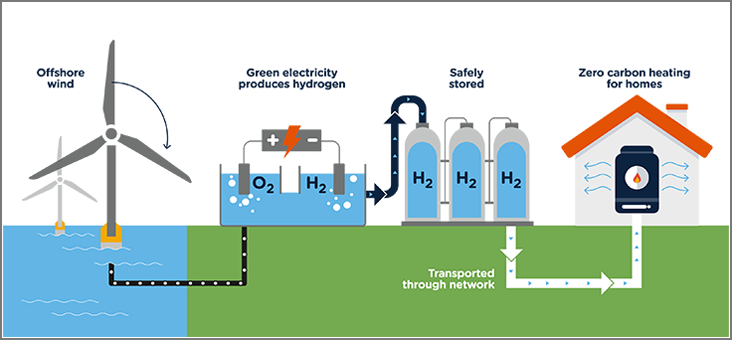
Saudi Arabia is building a futuristic city in the desert which will be a home to a million people. The city called Neom will be fully smart with robots as domestic helps and drones as taxis. Buildings will be smart and the city will function with aid of automation. But the city will not be powered by fossil fuels or nuclear or solar or wind energy. The city will be powered by a new fuel called ‘Green hydrogen’.
The Green hydrogen is a carbon-free fuel made from water by using renewably produced electricity to split hydrogen molecules from oxygen molecules. Green hydrogen (H2) is obtained either by steam reforming of bio-based feedstock or by splitting water by electrolysis. The electricity needed for this electrolysis process is generated exclusively from renewable sources. Many countries and companies across Europe, the Middle East and Asia are embracing this fuel.
While Saudi Arabia is banking on this futuristic fuel to run its new city, Australia has described Green hydrogen as a “transformative fuel” which is being adapted much faster than expected. Energy analysts have said that green hydrogen was likely to make hydrogen created with gas and coal as the most cost-effective form of the energy in the next few years and by the end of the next decade it could be fully adapted to the industry too.
Various reports from around the world suggest that a green hydrogen rush is already underway, and many companies, investors, governments and environmentalists believe it is an energy source that could hasten the end of fossil fuels and thus help in slowing global warming. Energy experts say that while wind and solar energy can provide the electricity to power homes and electric cars, green hydrogen could be an ideal power source for energy-intensive industries like concrete and steel manufacturing. It can also help the transportation sector that is more difficult to electrify.
Energy analysts opine that as the world adapts to newer forms of clean energy, it is the last 15% of the economy which is hard to clean up and this includes aviation, shipping, manufacturing, long-distance trucking. They believe that Green hydrogen can really hasten the process of clean up and aid faster adaptation to new fuel sources.
Europe, which is heavily dependent on Russian natural gas today, is investing heavily in green hydrogen by funding for construction of electrolysis plants and other hydrogen infrastructure. Germany has allocated the largest share of its clean energy stimulus funds to green hydrogen. Recently the European Commission opined that Green hydrogen “is the missing part of the puzzle to fully decarbonise the economy”. The statement reflects the EU’s commitment to adapt to green hydrogen.

However, not all energy experts are enthused with green hydrogen. Many say that issues in generating green hydrogen have not been sorted out. Michael Liebreich, a Bloomberg New Energy Finance analyst writes in an essay that since green hydrogen does not occur in nature, it requires energy to separate. “Its storage requires compression to 700 times atmospheric pressure, refrigeration to -253C… It carries one quarter the energy per unit volume of natural gas… It can embrittle metal, it escapes through the tiniest leaks and yes, it really is explosive.”
An energy consortium in Australia recently received environmental regulatory approval for a scheme to pipe hydrogen from a site near Pilbara in western Australia to Singapore. The scheme involved 1,600 large wind turbines and 30 square miles of solar panels to run a 23-gigawatt electrolysis factory to create its green hydrogen. But the facility, called the Asian Renewable Energy Hub, changed tack after recognising the difficulties of liquidising hydrogen and transporting it over such long distances, ABC News reported. Instead, the facility now plans to export ammonia, a more stable gas, instead.
As per estimates, to generate enough green hydrogen to meet a quarter of the world’s energy needs, it would take more electricity than the world generates now from all sources. It would also need an investment of $11tn in production and storage. It is due to similar issues that the world is currently focussed on only 15% of the economy being powered by alternative energy sources as industries such as heavy manufacturing, long-distance trucking, and fuel for cargo ships and aircraft cannot be easily supplied by wind and solar power.
Nevertheless, many energy experts believe that green energy cannot be the one stop solution as it is being made out to be but can certainly be part of the overall clean energy solution in the future. Supporters of Green hydrogen say that given the advantages of this new fuel source, we will ignore or not give its due importance at our own risk. They say that if it is manufactured with renewable energy, it is CO2-free. Experts say that Green hydrogen has the potential to address many of the problems that people think are unsolvable due to climate change and hence it is worth the effort, time and money invested so that we create a better alternative for all of us.
